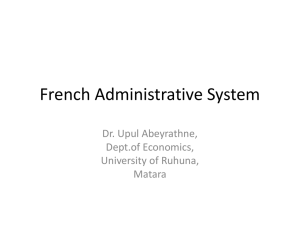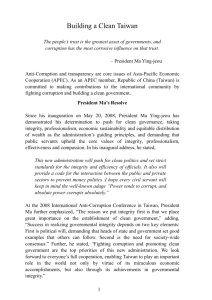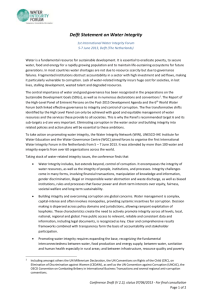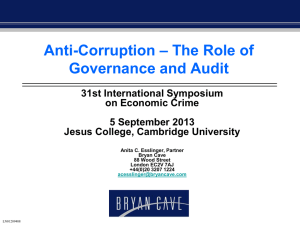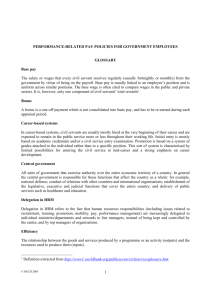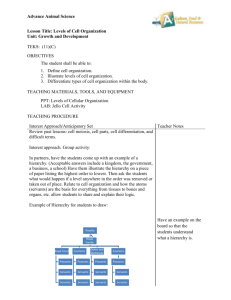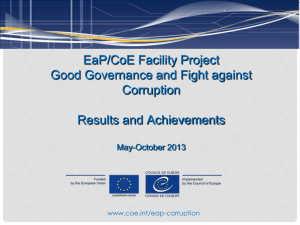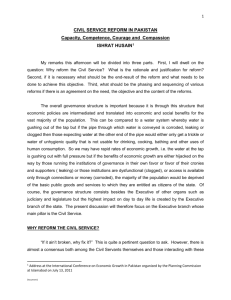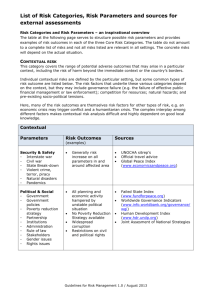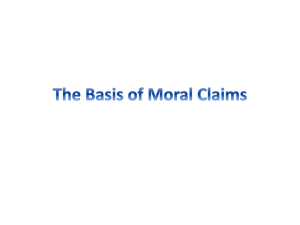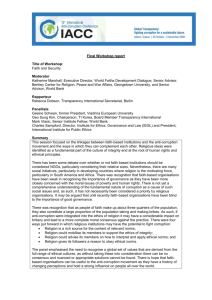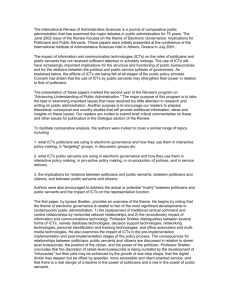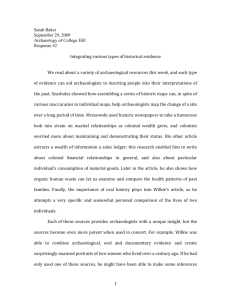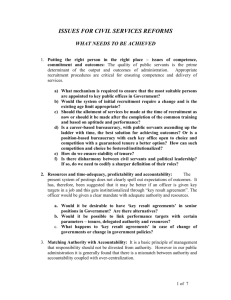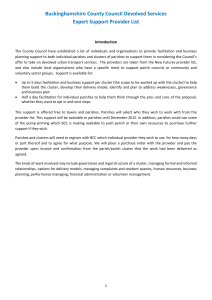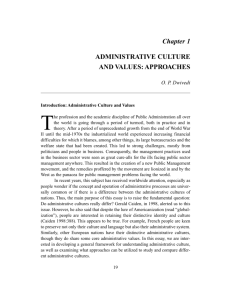Class_1 - Faculty of International Studies, HANU
advertisement
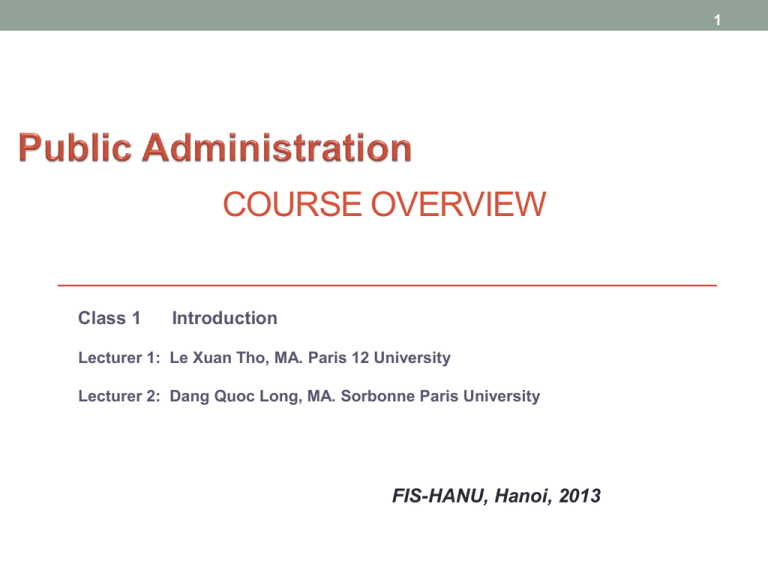
1 COURSE OVERVIEW Class 1 Introduction Lecturer 1: Le Xuan Tho, MA. Paris 12 University Lecturer 2: Dang Quoc Long, MA. Sorbonne Paris University FIS-HANU, Hanoi, 2013 2 I. II. About the lecturers Course overview 1. 2. 3. 4. 5. Course objectives Teaching methodology Course contents Course Requirements and Grading Reading materials III. Assignment IV. Group forming for presentation V. Key concepts and introduction to the subject PA VI. Discussion, Q& A 3 Lecturers • MA. Le Xuan Tho- Classes 1,3,5,6,7,9,10,12,13, 14,15 • MA. Dang Quoc Long (classes 2,4,8,11 TBC) 4 I. About the lecturer 1 • Mr. Le Xuan Tho – BA in Sociology- VNU, MA. in Economics and International Project Management, – Short courses on public administration, PM, HR, etc – 10 years experience in development sector: + nearly 4 years working for Ministry of Labor, Invalids, and Social Affairs, + 6 yrs worked for/with donors, INGOs: UNIFEM, UNDP, UNICEF, CARE, IFRC, etc – Interests: social policies, social work, poverty reduction, HIV/AIDS, anti- human trafficking, anti- corruption, etc – PhD student in Germany (short outlook). - Subjects delivered with FIS since 2009: Sociology, Development Studies, Minor Research, Cross- Culture, development policies - Now: Public Administration 5 Contacts • Email: le.xuantho.fis@gmail.com • Mobile: 094 522 8072 6 V. Key concepts • Public/ private (collective or individual ownership and social • • • • • • • • • • or profit motive) Public goods and service Public offices/ agencies/ Public and private sector, non- profit sector Management/ governance/ administration (sector?, stakeholders, aim?) Public administration and business administration Rights/ needs Citizen/ clients/customers/ user (rights and duties/ needs, satisfaction and willingness to pay) Servants/ officials Social contract and market contract Right- based approach/ needs- based approach 7 Cont. • Public- private partnership • Market failure • Planning or market economy • Role of the government/ the state • Functions of administration (planning, organizing, staffing, • • • • • • deciding, budgeting?) Public policy Ethics and public servants Human rights Civil society Cabinet/ government Local authority 8 Definitions of public administration • "public administration has no generally accepted definition", because • • • • • the "scope of the subject is so great and so debatable that it is easier to explain than define".[10] “PA has to keep the state going and exercise its public authority” (K. Walter, R. Stillman, 1996) both an academic discipline and a field of practice Public administration houses the implementation of government policy and an academic discipline that studies this implementation and that prepares civil servants for this work.[1] As a "field of inquiry with a diverse scope" its "fundamental goal... is to advance management and policies so that government can function."[2] "the management of public programs";[3] the "translation of politics into the reality that citizens see every day";[4] 9 PA definitions • "the study of government decision making, the analysis of the policies themselves, the various inputs that have produced them, and the inputs necessary to produce alternative policies."[5] • "centrally concerned with the organization of government policies and programmes as well as the behavior of officials (usually non-elected) formally responsible for their conduct"[6] • Many unelected public servants can be considered to be public administrators: heads of city, county, regional, state and federal departments such as municipal budget directors, human resources (H.R.) administrators, city managers,…[4] Public administrators are public servants working in public departments and agencies, at all levels of government.[4] 10 The North American Industry Classification System , 1991 • "... comprises establishments primarily engaged in activities of a governmental nature, that is, the enactment and judicial interpretation of laws and their pursuant regulations, and the administration of programs based on them". • This includes "Legislative activities, taxation, national defense, public order and safety, immigration services, foreign affairs and international assistance, and the administration of government programs are activities that are purely governmental in nature".[12] 11 the National Center for Education Statistics (NCES), USA • PA: "A program that prepares individuals to serve as managers in the executive arm of local, state, and federal government and that focuses on the systematic study of executive organization and management. Includes instruction in the roles, development, and principles of public administration; the management of public policy; executive-legislative relations; public budgetary processes and financial management; administrative law; public personnel management; professional ethics; and research methods."[13] 12 References • 1. ^ Random House Unabridged Dictionary • 2. Handbook of Public Administration. Eds Jack Rabin, W. Bartley • • • • • • Hildreth, and Gerard J. Miller. 1989: Marcel Dekker, NY. p. iii 3. Robert and Janet Denhardt. Public Administration: An Action Orientation. 6th Ed. 2009: Thomson Wadsworth, Belmont CA. 4. Kettl, Donald and James Fessler. 2009. The Politics of the Administrative Process. Washington D.C.: CQ Press. 5. Jerome B. McKinney and Lawrence C. Howard. Public Administration: Balancing Power and Accountability. 2nd Ed. 1998: Praeger Publishing, Westport, CT. p. 62 6. UN Economic and Social Council. Committee of Experts on Public Administration. Definition of basic concepts and terminologies in governance and public administration. 2006 12. ^ Definition Public Administration (NAICS 91). Available online at: http://www.ic.gc.ca/cis-sic/cis-sic.nsf/IDE/cis-sic91defe.html Accessed October 25, 2010 13.http://nces.ed.gov/ipeds/cipcode/cipdetail.aspx?y=55&cipid=88560 accessed 09.03.2011 13 Social contract theory, • persons’ moral and/or political obligations are dependent upon a contract or agreement among them to form the society in which they live. • Socrates uses something quite like a social contract argument to explain to Crito why he must remain in prison and accept the death penalty. • is rightly associated with modern moral and political theory and is given its first full exposition and defense by Thomas Hobbes, then John Locke, Jean-Jacques Rousseau are the best known proponents of this enormously influential theory, which has been one of the most dominant theories within moral and political theory throughout the history of the modern West. 14 Social contract • In the twentieth century, moral and political theory regained philosophical momentum as a result of John Rawls’ Kantian, David Gauthier and others. • Recently, new criticisms of social contract theory by feminists and race-conscious philosophers: at least an incomplete picture of our moral and political lives, and may in fact camouflage/ hide some of the ways in which the contract is itself parasitical upon the subjugations of classes of persons. • Source: http://www.iep.utm.edu/soc-cont/ Public goods… “These are a very special class of goods which cannot practically be withheld from one individual consumer without withholding them from all (the “nonexcludability criterion”) and for which the marginal cost of an additional person consuming them, once they have been produced, is zero (the “non-rivalrous consumption” criterion). The classic example: a nearly pure public good is national defense: you cannot defend the vulnerable border regions of a country from the ravages of foreign invaders without also simultaneously defending everyone else who lives within the borders. “ Paul Jonhson Public institutions --“The part of an economy in which goods and services are produced and/or (re) distributed by government agencies.” Example : municipalities, public services… -- Is to be opposed to the private sector, Example : enterprises, banks… -- There is also a third sector regrouping NGO’s, non profitable organizations… Example : Oxfam, SC, WV, Plan, CARE, Greenpeace, religious organizations, … Definition… Public institutions Private sector Third sector NGO’s Financing budget Private money Mixed, subsidies Control State, Capital political authorities Public good, Profit max. redistrib. Objectives Citizens… donors Public good Examples of public institution’s crisis • Education : the quality of the teaching is questionable…in • • • • some cases corruption Health : corruption, or additional payments are requested. Quality, transparency, expertise is asked by clients Security : is the State protecting citizens?… Justice : every citizen should be equal in front of the Law? (Rule of Law) etc… 19 • There is virtually no aspect of our work that does not have a human rights dimension. Whether we are talking about peace and security, development, humanitarian action, the struggle against terrorism, climate change, none of these challenges can be addressed in isolation from human rights. • Ban Ki-moon, Secretary-General of the United Nations WB Governance indicators • Voice and Accountability • Political Stability and Absence of Violence • Government Effectiveness • Regulatory Quality • Rule of Law • Control of Corruption 21 Example: Public Administration International (PAI) to provide advice and support to public sector organisations and other bodies involved in the delivery of public services, and to facilitate the exchange of ideas and experiences. We specialise in management consultancy and development services for organisations in and associated with the public sector worldwide. We offer expert advice to governments that are undergoing political, constitutional, economic and structural change. The promotion of good governance and best practice in delivering public services are our key objectives. We are committed to high standards of ethical conduct. 22 PAI study programmes for policy makers and senior managers in civil service and local government, to academics, politicians and civil society organisations … update their knowledge of public service structures and systems. • • • • • • • • • • • • • • • • • • • • • Access to civil justice: Efficiency, affordability and fairness Better regulation: Economic regulation of utilities Changing the law: Successful reform Competition policy: How to level playing field Consultancy for the public sector: A foundation in essential consultancy skills Crisis communication in government Doing business: Promoting private sector development and economic growth Film, governance and society: Funding, classification and promotion Government: image and communication. The UK experience Heritage and tourism: Policy and practice for maximising benefits Internal audit and risk management: Achieving organisational objectives Managing elections: Techniques and perspectives Managing the performance of public sector organisations Pay and grading: Strategies for change Pension schemes: planning for the future. The UK experience Protecting society: Challenges in delivering effective prison services and alternatives to custody Public law in changing times: How do government lawyers respond? Public-private partnerships: The UK experience of roads and transport Public service commissions: Professionalism, performance - excellence Putting people first: The key to improving public services Successfull cities: Promoting economic growth and sustainable development 23 Public and private sector difference • Organization level: • Managerial level: • Employee level: 24 Public and private sector difference • Organization level: + pub: large number of formal processes to ensure that it functions. • + Red tape: “rules, regulations and procedures that remain in force and entail a compliance burden for the organisation but have no efficacy for the rules’ functional object” (Bozeman, 1993) • + Kurland and Egan (1999), public org have higher levels of red tape, because authority is divided among three main branches: executive, legislative and judicial • +degree of formalisation of the public sector far exceeds that of the private sector. (Baldwin, 1990; … Feeney & Bozeman, 2009). + Boyne (2002): public orgs …more ambiguous objectives. Lan and Rainey (1992):s more difficult to calculate to what extent public objective are met. 25 Public and private sector difference • Managerial level: + decision making process: conflict in a strategic decision has a positive component or negative sign + different stakeholders interests or not + decisions related to budgets: value consultative practices or use analytical practices. • Employee level: place higher a value on carrying out tasks that are of use to society / economic rewards (de Graaf & van der Wal, 2008). 26 the public sector ethos a) a performance culture a strong commitment to serve for individuals and the community; b) a commitment to accountability: a great emphasis on open access to information; c) a capacity to support universal access: recognition of the special responsibility to support the rights of all service users in an environment; d) responsible employment practices; and finally, e) a contribution to community well-being. • Aldridge and Stoker (2002) 27 new public management • In the approach preferred by new public management, the public sector appears to be adopting practices that are often attributed to the private sector in order to achieve greater efficiency • Below diagrams come from UN PA network’s e-course 28 29 30 31 32 33 34 35 Q &A 36 • Thanks for your attention!

